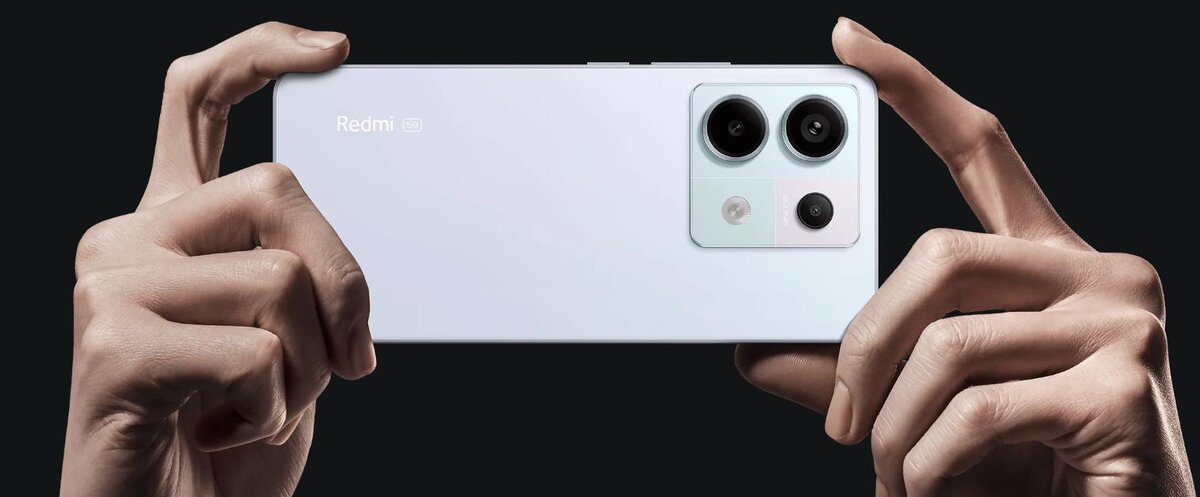In typical Xiaomi style, the manufacturer has made the Note 13 series a bit complex and rich. Today, we will look at the most popular model – Redmi Note 13 Pro (5G).
The latest Redmi Note 13 Pro is a significant upgrade over the Redmi Note 12 Pro: an improved display with a higher resolution, greater brightness and a richer color gamut. It also features a more powerful chipset, increased storage capabilities and an improved main camera. The QUEC team has prepared a detailed review of the Xiaomi Redmi Note 13 Pro 5G.
The Redmi Note 13 Pro comes in a sturdy white cardboard box. The package includes the phone itself, a 67W adapter, a USB-AC cable, and a protective case.
The Note 13 Pro’s screen has a thin film that provides enough protection against scratches, but is also a huge smudge magnet.
Design

Even if the internals of the Poco X6 and Redmi Note 13 Pro are almost identical, their appearance is different.
Unlike the Poco X6, the Redmi Note 13 Pro does not have a prominent black spot with the Poco logo on the back. Instead, we have the traditional Xiaomi design with a square camera block, thin partitions and protruding rings around the lenses.
The Xiaomi Redmi Note 13 Pro looks sophisticated, with flat glass panels and a plastic frame. The screen is protected by Gorilla Glass Victus.
The smartphone is available in three colors: Midnight Black, Aurora Purple and Ocean Teal. It seems that the only matte variant – Arctic White – remains exclusive to the Chinese market.
The Redmi Note 13 Pro has an IP54 rating for protection against dust and splashes. The IPX4 rating for water resistance allows the device to withstand exposure to water from all sides for 5 minutes, which provides reliable protection, for example, during rain.
The dimensions of the Redmi Note 13 Pro are 161.2 x 74.2 x 8 mm and weighs 187 grams, which is 2 mm shorter and lighter than the Redmi Note 12 Pro, thanks to the thinner screen bezels.
The overall experience of using the Redmi Note 13 Pro is positive: the matte frame with sharp edges and the matte back panel provide a secure grip and prevent smudges. Overall, the experience of using the Note 13 Pro is one of satisfaction.
Display
The display of the Redmi Note 13 Pro is similar to the one featured on the Poco X6 and vice versa. It is a high-quality OLED panel measuring 6.67 inches diagonally and featuring a resolution of 1220 x 2712 pixels, which translates to 446 pixels per inch. This display offers impressive specs like 12-bit color depth, 120Hz refresh rate, 1920-degree PWM dimming technology, and support for HDR10+ and Dolby Vision content.
The display is protected by Gorilla Glass Victus. According to Xiaomi’s official listing, the display supports a peak brightness of up to 1800 nits. While there is no exact information about the maximum brightness, we can assume that it is similar to the Poco X6, which is around 1200 nits.
The display supports a refresh rate of up to 120Hz, offering two modes: Custom (with the ability to choose between 120Hz and 60Hz) and Default (automatic switching). Fixed refresh rates of 30Hz, 60Hz, 90Hz, and 120Hz are supported.
Adaptive refresh rate technology works effectively: it drops to 60Hz when displaying static content. All streaming apps are capped at 60Hz, and apps that are not compatible with high refresh rates run at 60fps. Always-on Display mode operates at 30Hz and is activated for a short time – just 10 seconds.
Redmi Note 13 Pro supports Widevine L1 DRM, enabling Full HD streaming with HDR10 and Dolby Vision on popular platforms.
Battery
The Redmi Note 13 Pro has the same 5100mAh battery as the Poco X6.
Most of the latest Xiaomi smartphones support 67W fast wired charging, and the Redmi Note 13 Pro is no exception. The smartphone charges 49% in 15 minutes and 83% in 30 minutes. A full charge takes 42 minutes, which is quite fast.
Performance and Software

The Redmi Note 13 Pro runs MIUI 14 on top of Android 13. There is no exact information about update support yet, but it will probably be similar to the Poco X6 models – three years of major Android updates and an additional year of security updates. The
Redmi Note 13 Pro is the second smartphone to come with Qualcomm’s Snapdragon 7s Gen 2 chipset, which is built on a 4nm process. This chipset, although less powerful than the 7+ Gen 2 or the original 7 Gen 1, offers improved performance compared to the previous Redmi Note 12 Pro model, which was equipped with Dimensity 1080. The Snapdragon 7s Gen 2 includes an octa-core processor with four Cortex-A78 cores (2.4 GHz) and four Cortex-A55 cores (1.95 GHz). The Adreno 710 GPU supports FHD+ resolution at 144 Hz.
The Redmi Note 13 Pro is available in two LPDDR4X RAM + UFS2.2 storage configurations: 8GB + 256GB and 12GB + 512GB.
AnTuTu benchmarks compare the performance of the Redmi Note 13 Pro with the Poco X6, Galaxy A54, and Realme 11 Pro.
Stability tests showed high performance – 70% CPU stability and 99% process stability. The overall performance of the Redmi Note 13 Pro in the mid-range of affordable devices is impressive, surpassing the previous model Redmi Note 12 Pro.
Camera
The Redmi Note 13 Pro 5G offers an impressive 200MP main camera with a large 1/1.4-inch sensor and 0.56μm pixels working under a wide f/1.7 aperture. This sensor, which could previously be considered a feature of flagship devices, is the main difference between the Redmi Note 13 Pro 5G and the Poco X6, which has a 64MP camera.
Along with the main camera, there is an 8MP ultra-wide-angle camera with a 118-degree field of view and a 2MP macro shooter with an f/2.4 aperture. On the front, there is a 16MP selfie camera with an f/2.4 aperture, which is a typical configuration for Xiaomi smartphones.
The 200MP camera shows its best qualities in daylight conditions. The night mode impresses with its automatic behavior and low-light shooting quality. The 200MP mode, although it provides additional detail, is not always justified due to noise. The 2x zoom mode, on the other hand, demonstrates stability and minimal loss of quality. The ultra-wide-angle
camera is not very impressive, leaving much to be desired in terms of contrast and dynamic range. The macro camera, although capable of good shots in bright light, is limited to 2MP resolution and lacks autofocus.
Video recording is possible in 2160p on the main camera and 1080p on the ultra-wide-angle camera.
Conclusion
As we mentioned, the Redmi Note 13 Pro is a significant improvement over its predecessor. It’s a solid all-rounder with virtually no shortcomings. The outstanding display, good performance, unrivaled main camera, and competitive fast charging solution make it an attractive choice. The only thing we would like to see is an improvement in the ultra-wide-angle camera and the hardware proximity sensor.
Do we approve of the Redmi Note 13 Pro? Definitely yes! We’re confident that the Redmi Note 13 Pro will remain competitive for a long time to come.





